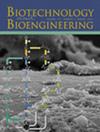Engineering Yarrowia lipolytica for Enhanced Gastrodin Production via High-Throughput Screening and Transcriptomics-Guided Optimization
IF 3.5
2区 生物学
Q2 BIOTECHNOLOGY & APPLIED MICROBIOLOGY
引用次数: 0
Abstract
Gastrodin, the principal bioactive component of the renowned herb Gastrodia elata, is extensively utilized in medicinal drugs and nutraceuticals. This study seeks to enhance microbial production of gastrodin through high-throughput screening (HTS) and transcriptomics-guided optimization. Initially, atmospheric pressure and room temperature plasma (ARTP)-mediated mutagenesis were employed to develop a library of mutant strains. Furthermore, a transcription factor-based biosensor and a high-throughput solid-phase extraction mass spectrometry (HP-SPE-MS) were evaluated to establish an HTS method for gastrodin. Consequently, mutant strain MT8 was isolated, producing 9.8 g/L of gastrodin in YPD medium, which represents a 55.6% increase compared to the control strain. Next, key genes identified via transcriptomics were overexpressed in strain MT8, with the overexpression of gene YALI2E01737g, a gene involved in the synthesis of aromatic amino acids, significantly enhancing gastrodin production to reach 10.1 g/L. In addition, fermentation process optimization further improved gastrodin titer up to 13.1 g/L in shaking flasks. This study demonstrated the utility of HTS techniques to enhance gastrodin production and paved the way for its future industrial application.

通过高通量筛选和转录组学指导下的优化工程来提高脂肪分解酵母的胃泌素产量
本文章由计算机程序翻译,如有差异,请以英文原文为准。
求助全文
约1分钟内获得全文
求助全文
来源期刊

Biotechnology and Bioengineering
工程技术-生物工程与应用微生物
CiteScore
7.90
自引率
5.30%
发文量
280
审稿时长
2.1 months
期刊介绍:
Biotechnology & Bioengineering publishes Perspectives, Articles, Reviews, Mini-Reviews, and Communications to the Editor that embrace all aspects of biotechnology. These include:
-Enzyme systems and their applications, including enzyme reactors, purification, and applied aspects of protein engineering
-Animal-cell biotechnology, including media development
-Applied aspects of cellular physiology, metabolism, and energetics
-Biocatalysis and applied enzymology, including enzyme reactors, protein engineering, and nanobiotechnology
-Biothermodynamics
-Biofuels, including biomass and renewable resource engineering
-Biomaterials, including delivery systems and materials for tissue engineering
-Bioprocess engineering, including kinetics and modeling of biological systems, transport phenomena in bioreactors, bioreactor design, monitoring, and control
-Biosensors and instrumentation
-Computational and systems biology, including bioinformatics and genomic/proteomic studies
-Environmental biotechnology, including biofilms, algal systems, and bioremediation
-Metabolic and cellular engineering
-Plant-cell biotechnology
-Spectroscopic and other analytical techniques for biotechnological applications
-Synthetic biology
-Tissue engineering, stem-cell bioengineering, regenerative medicine, gene therapy and delivery systems
The editors will consider papers for publication based on novelty, their immediate or future impact on biotechnological processes, and their contribution to the advancement of biochemical engineering science. Submission of papers dealing with routine aspects of bioprocessing, description of established equipment, and routine applications of established methodologies (e.g., control strategies, modeling, experimental methods) is discouraged. Theoretical papers will be judged based on the novelty of the approach and their potential impact, or on their novel capability to predict and elucidate experimental observations.
 求助内容:
求助内容: 应助结果提醒方式:
应助结果提醒方式:


